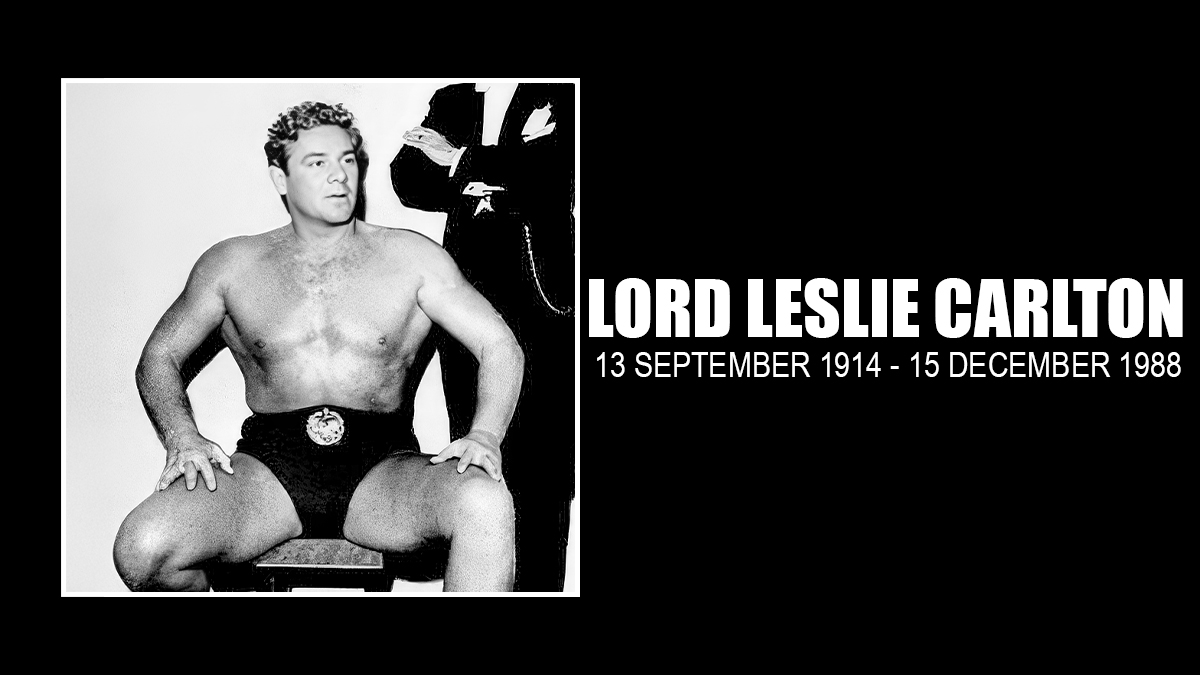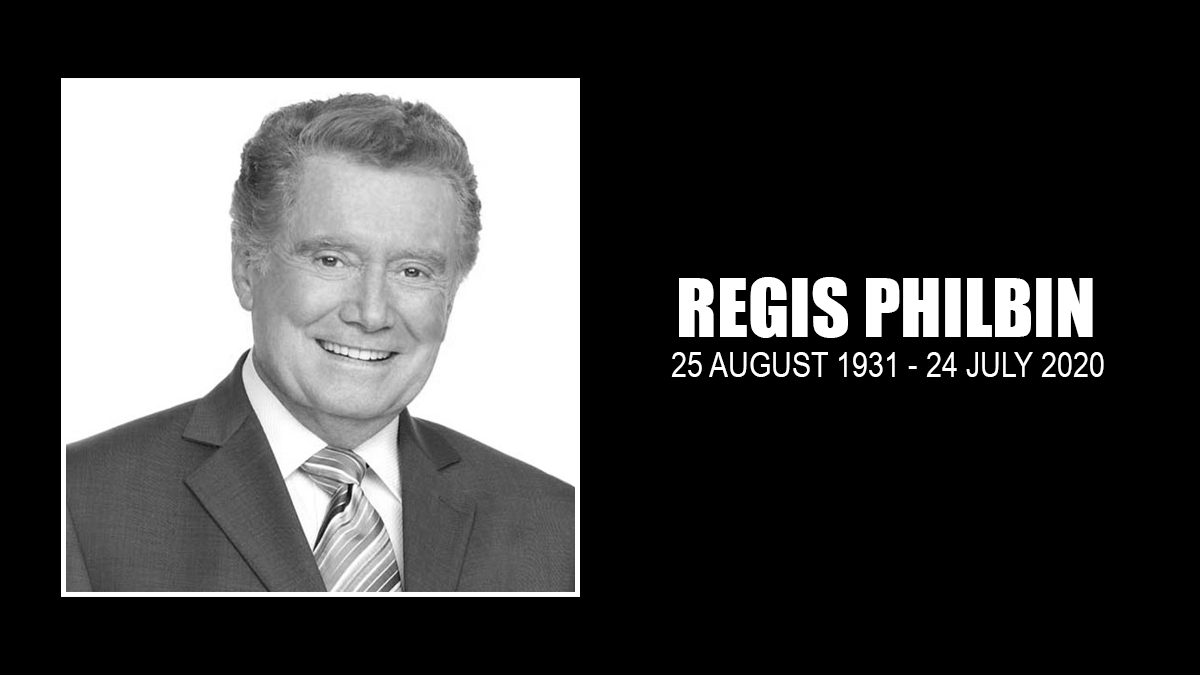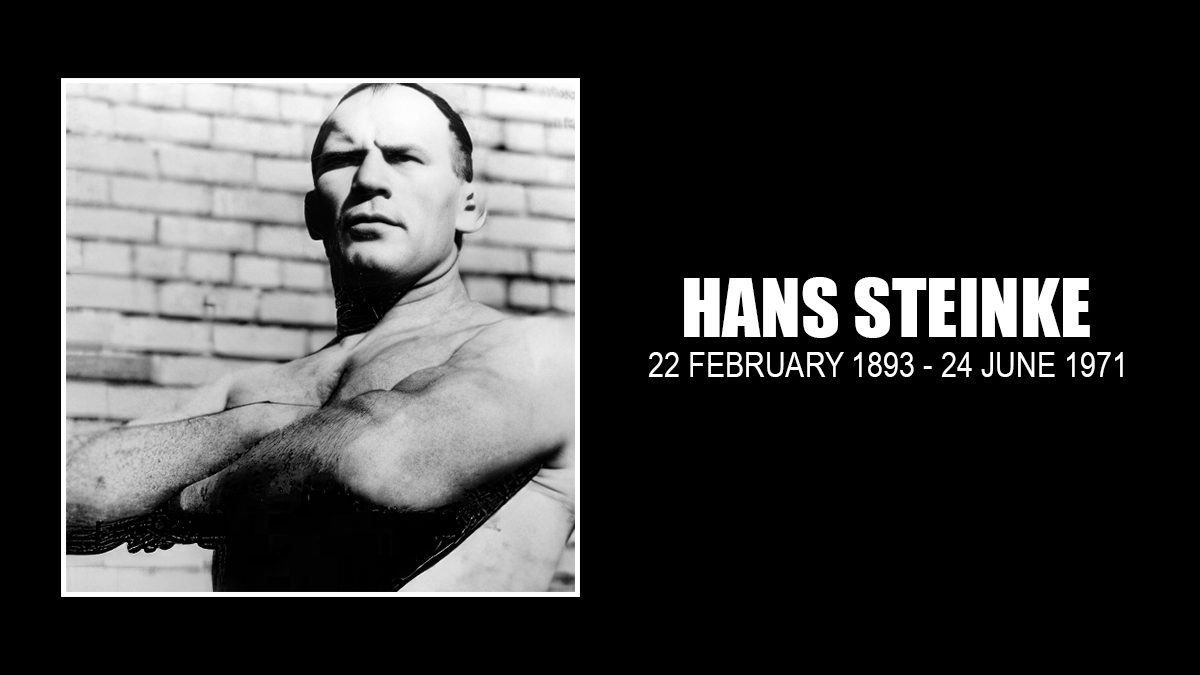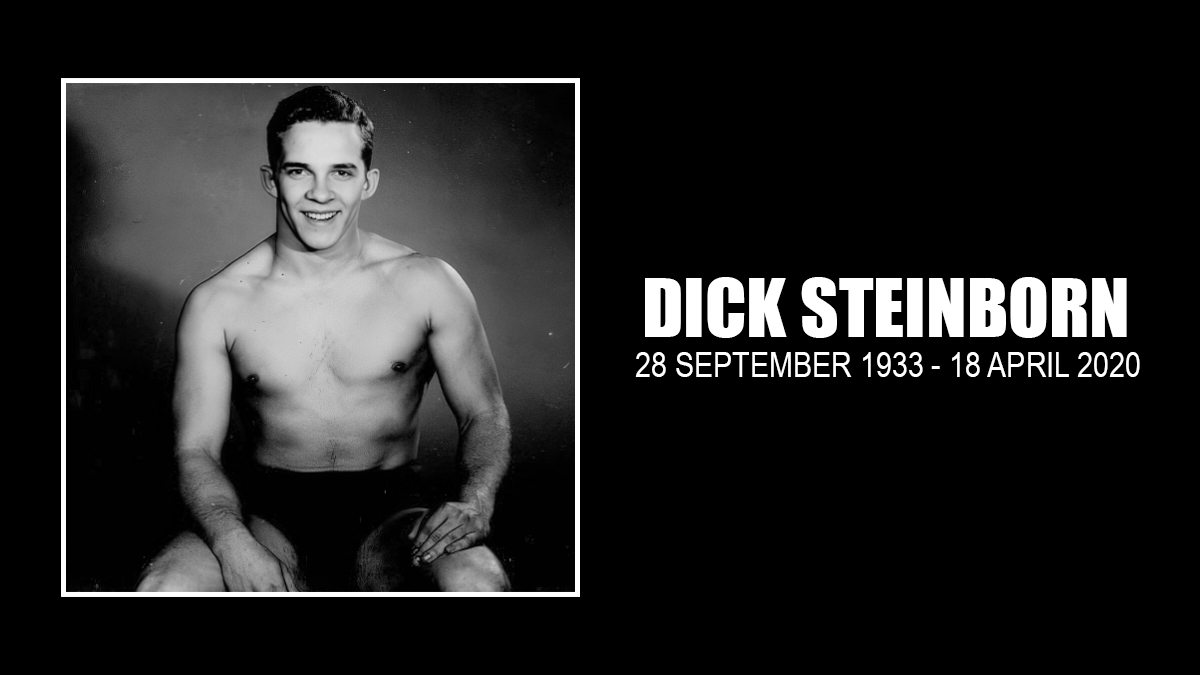Leo Whippern could have led the life of a starving artist. Instead, he became British nobility.
The transition wasn’t always smooth, but, in essence, that’s the path that a son of Hungarian immigrants took in restyling himself as Lord Leslie Carlton, one of wrestling’s most couth and hated villains of the 1950s.
“He wanted to be an artist when he was painting as a child, but he said he was smart enough to know that’s a difficult business,” said his daughter, K.K. Carlton-Fluegeman. “As a wrestler, he had an outlet for his imagination.”
Though Carlton painted all his life, his condescending wrestling countenance obscured his talent with a brush and easel. Fifty years after his retirement from the ring, that’s changing, thanks to the efforts of his daughter.
She has preserved about 100 originals, some of which were on display at the recent Cauliflower Alley Club reunion in Las Vegas. It’s been a labor of love for K.K., whose mother Gwen was determined to discard all of the compositions after his lordship died on December 15, 1988 at the age of 74.
“My mother didn’t want anything and she was even throwing his paintings away. She thought they were haunted,” K.K. said. “I was still a teenager. I took all the paintings. The stuff has been in the closet all this time and I am kind of trying to resurrect this now and show the world what a great artist he was.”
The range — and for that matter, size — of Carlton’s work is impressive, from paintings of Jesus Christ to Hulk Hogan to an immaculate five-foot-high depiction of the city of San Francisco that once loomed over his bed and now hangs in his daughter’s bedroom.
But what else would you expect from a child prodigy whose sketches as an eight-year-old earned him a scholarship to a fine arts school in San Francisco? K.K still has the papers relating to the award.
“He was 60 when I was born, so I only ever saw him painting,” she said. “All he wanted to do was paint all the time.”
HITTING THE MAT
Whether he was wielding a palette knife or a hammerlock, creative juices flowed in Carlton’s bloodline. His parents fled Hungary for California to escape World War I. His father composed music for the Barnum & Bailey Circus, among other gigs, while his mother sang and danced professionally up and down the West Coast.
When he was 12, a bad accident diverted Carlton from the pursuit of fine arts. Playing on a street in San Francisco, he scraped his elbow and contracted blood poisoning in the days before wonder drugs like penicillin.
Carlton needed an arm-to-arm blood transfusion from an uncle and was in and out of a hospital for months. By the time he was discharged, he was emaciated and driven to rebuild his physique.
“He vowed to himself at 12, ‘I will never be sick and thin again. I am going to be as strong as I can possibly be,'” K.K. said.
Throwing himself into athletics, Carlton earned a mention in the Oakland Tribune in 1936 as a top competitor for the Fleishhacker Swimming Club, competing in the two-mile Golden Gate Swim along Neptune Beach.
He started wrestling at the Olympic Club and the YMCA in San Francisco. In boxing, he was a local Golden Gloves champion at 17, until the constant pummeling caused him to rethink his choice of professions.
“He’d say, ‘I didn’t want to have a career of being hit in the head so much. I wanted to wrestle.’ He felt it was a little more flamboyant, artistic, and his whole family was entertainers,” K.K. said.
The details of his training and his first match have been lost to the mists of time, but Carlton was a regular on the California mat scene by 1941, billed as “Tug” Carlson, a sandy-haired sailor who resembled Flash Gordon of movie reel fame.
Carlton’s early opponents included heels such as Rudy LaDitzi, Bronco Valdez and future world champion “Wild” Bill Longson, and he graduated to main event spots in some smaller California markets by 1943.
The “Tug” label was no affectation. Carlton enjoyed boating and sailing, and later christened his personal houseboat as “Tugboat.” He formalized his nautical alliance in July 1944, when he enlisted in the U.S. Navy, where he served until January 1946.
FROM TUG TO LORD
When he returned to wrestling, Carlton — or Carlson — headed to San Antonio, Texas, in spring 1946 to feud with Freddie Blassie, Buddy Rogers, and a hot property named Gorgeous George, whom he battled to a no contest.
But bigger and better things were in store.
In late 1949, following in the footsteps of snooty faux Englishmen like Lord Lansdowne, Carlton accepted a promotional makeover. He took on a nobleman’s manifestation and added a valet or swami, depending on the venue — brother-in-law Frank Romano sometimes served in that capacity. Instead of being advertised as a cheery seaman, he was the “Personification of Perfection.”
The results were immediate. Carlton headlined in Madison Square Garden in New York on May 15, 1950 against Antonino Rocca, the territory’s leading star — they drew 14,246 fans and a $43,311 gate.
“The queen sent him some kind of a promotion and he became a lord,” his friend and fellow wrestler Ted Tourtas recalled with a laugh. “We had all kinds of lords in those days. Lord Blears. Lord Layton. What the hell they call the strip with all the politicians in England? [Downing Street] Yeah, well, they left that and they all became wrestlers. Lord Albert Mills. There’s nobody there to rule England!”
In an unusually frank interview in 1952, Pedro Martinez, who ran the Manhattan wrestling booking office with Toots Mondt, admitted Carlton was Carlson.
“His real name is Leo Whippern and he came from San Francisco. He used to wrestle under the name of Tug Carlson of the U.S. Navy,” Martinez told Jack Hand of the Associated Press. “We thought up the gimmick of the monocle and valet. All he has to do is work in the ring. We do the rest.”
If that was the case, someone should have notified Emma Talmadge, a fan in Baltimore. In March 1952, she slapped Carlton with a $10,000 personal injury lawsuit, claiming she required medical treatment for her left side after Carlton smacked her as he shoved his way through a hostile Baltimore Coliseum crowd.
The courtroom fight between the 220-pound Carlton and the 122-pound Talmadge was a rout, with Carlton scoring the acquittal pinfall in 97 minutes. The proceedings were one for the tongue-in-cheek ages. Hyman Pressman, Talmadge’s lawyer, placed a newspaper ad soliciting an amateur wrestler “to prove Lord Leslie Carlton is a big bum by wrestling him under AAU rules.”
Carlton responded by challenging Pressman to a match “anytime, anyplace,” and testified that he couldn’t possibly have flattened Talmadge.
“I was flanked fore and aft by ushers. Perhaps this is a case of racial discrimination because I’m British,” he said, according to a United Press news story. When asked whether he was, in fact, a lord, Carlton’s upturned his nose. “That question is irrelevant, immaterial, and has no bearing on this case,” he maintained.
“Well, you were a detestable villain that night, weren’t you?” Talmadge’s lawyer persisted. “Detestable? In my opinion, I’m not detestable,” Carlton responded.
When he returned to California, Carlton continued as a headliner, running roughshod over most of the competition. “Carlton’s ‘dislike quotient’ was about as high as a wrestler’s unpopularity can get without the fans becoming a lynch mob,” wrestling writer Thomas J. Cumming observed.
The lord held the International Tag team Title in California three times, twice with Lord Blears and once with Don Leo Jonathan. In a fitting summation, Sports Illustrated declared in 1956 that “Lord Carlton of England looks at the crowd as if it were dirt.”
Carlton finished up in Arizona in the late 1950s, though he worked a couple spot shows in 1962 in Utah and Nevada for promoter friends.
“I had a great match with Lord Carlton — his last — and he always got kidded by him saying I retired him,” said Arizona wrestling legend Phil Melby, who crushed Carlton’s lip when he hit him in the face with a chair. “He also was a great guy and a great wrestler.”
AFTER THE JEERING STOPPED
Envision the artist in his studio, brush in hand, colors at the ready, amid the trappings of refinement. In later years, Carlton’s workplace was his oversized bedroom at his home in Canyon Lake, Calif., and its stateliness led one to wonder whether Lord Leslie had permanently subjugated poor old Tug.
The room was carpeted in royal blue, with heavy royal blue velvet drapes framing the windows. It had a leather sofa, a leather love seat, gothic-style nightstands and lamps made out of suits of armor. French doors opened to a patio overlooking a lake, and the gold-framed painting of San Francisco hung above his king-sized bed.
No wonder he rarely left his workspace.
“He was very aesthetic. He liked the aesthetic look of that kind of era. He just kind of had an old world aesthetic taste,” K.K. said. “We’d try to get him to go some place and he’d say, ‘I’ve been all over the world. This is my vacation, living in Canyon Lake.'”
And, truth be told, Carlton was an art snob, with as much contempt for the unwashed masses who might buy the fruits of his labor as disdain for the ones who jeered him at ringside.
If someone expressed an interest in his paintings, he would give them away for free. Others might go on display at a gallery. But under no conditions would he sell them.
“He would tell me America has no culture, no sophistication. People have to be told what to buy,” K.K. said.
“He hated abstracts. He was like, ‘You could have a monkey sit on [the canvas], spin around drunk and it would come out looking the same.’ So he was very critical of things like that. So he would just say, ‘There’s no point in selling. I will not sell anything because American audiences, they are filthy pigs and they have no taste and they have to be told what to buy.'”
Carlton could afford a life of leisure because his invested his earnings well. He bought apartment complexes in Santa Monica — the Lord Carlton Apartments are still a staple of the city’s housing market. He swore off red meat and refined sugar, and went deep-sea fishing with friends to catch the freshest salmon.
A fitness nut, he installed a punching bag in his garage, where he’d pound away to the strains of his beloved classical music. “So I’m a kid growing up to the ‘Overture of 1812’ while he’s punching and punching and punching,” K.K chuckled.
Full as his life was, Carlton was haunted by tragedy. In 1947, he married a pretty actress from Texas named Peggy Jean Parker. Their brief marriage produced a son, Rich. Carlton subsequently married Gwen, 20 years his junior; they had two sons and K.K.
In January 1970, Rich murdered Peggy, the first wife, stabbing and choking her at her home in Houston in a bizarre replication of Abraham’s sacrifice of Jacob in the Bible. Rich, who had been in and out of mental hospitals four times in three years, told a policeman that he killed his mother at God’s behest.
“God told me that I was an abomination, a wretch, a Judas, but if I had faith, I could raise her,” he said, according to sensational newspaper reports of the day.
From that point, K.K. said, Carlton disassociated himself from his son and became an atheist. “I think his issue with God was, ‘Why’d you take my son?'” she said.
But there was a lot of joy to go around. Carlton reached out to the homeless in the community, supported numerous civic projects, and hosted old buddies at his house.
“Rube Wright used to come to our house a lot. I knew him as Santa Claus,” K.K. said. “My father told me he was Santa Claus. So he would come over and he would have a cane and a limp, right? And I would ask my father, ‘Why does Santa Claus have a cane and a limp?’ And he would say because one of the reindeers bit him.”
“We used to have Freddie Blassie come over to the house all the time and he would bring his snakes. My father thought Freddie Blassie was really cool because he had a snake. So to me, Freddie Blassie was the guy with the snake; Rube Wright was Santa Claus.”
In death, Carlton’s service to his country (America, not Great Britain) is recognized by his burial at Riverside National Cemetery in Riverside, Calif.
From all indications, he passed the family creative genes to his youngest child. K.K. sings with perhaps the planet’s only heavy metal German polka band. The group is named Kranken Welpen, and is well known on the California scene; a sample of its cheeky, off-the-wall music is available on its Facebook page.
If Carlton was renowned for his gold and purple velvet ring attire, his daughter is known for her top hat and black leather costume. She thinks he’d approve.
“I wish he was around because he would think it is fantastic,” she said. “He liked being the villain. … I prefer playing the villain. I’m always the villain. In our band, I’m the bad guy. They call me ‘Chaos.'”




